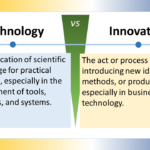The difference between technology and innovation is rooted in their roles in progress and development.
Technology refers to the tools, systems, and machines that are the result of scientific knowledge being applied for practical purposes.
Innovation is the process of translating an idea or invention into a good or service that creates value or for which customers will pay.

Definition
Technology
Technology encompasses the collection of techniques, skills, methods, and processes used in the production of goods or services or in the accomplishment of objectives, such as scientific investigation.
- Characteristics of Technology:
- Tool Creation: Involves the design and development of tools and systems.
- Practical Application: Uses scientific knowledge for practical purposes.
- Facilitation: Aims to facilitate tasks, solve problems, and improve human capabilities.
Innovation
Innovation refers to the application of better solutions that meet new requirements, unarticulated needs, or existing market needs.
- Characteristics of Innovation:
- Novelty: Involves new ideas or ways of doing something.
- Implementation: Not just conceptual; it requires the practical application of ideas.
- Market Orientation: Must be economically viable and fulfill a specific customer demand.
More Synonyms on innovation, innovate and innovative
Innovation Terms

Innovation is considered as a driving force in progress.
It includes the introduction of novel ideas, methods, or products that bring positive change and advancement.
For more information about innovations, check our glossary
Relationship and Relevance
Technology and innovation are closely linked. Technological advancements often provide the tools and resources necessary for innovation. Conversely, innovation can lead to the development of new technologies. While technology is the enabler, innovation is the act of applying it in a way that introduces new or improved solutions.
The key difference between technology and innovation is:
Technology refers to the application of scientific knowledge and discoveries to create tools, devices, and systems that solve practical problems or improve existing processes. It involves the practical implementation of scientific principles and inventions.
Examples of technology include computers, smartphones, medical devices, transportation systems, and manufacturing equipment. These are the tangible products and applications that leverage scientific advancements.
Innovation, on the other hand, is the introduction of something new - a novel concept, product, service, or way of doing things that did not exist before. It goes beyond just applying technology and creates something fundamentally different.
Innovations, such as the creation of the smartphone or the ridesharing model pioneered by Uber, disrupt existing industries and change the status quo in a significant way. They are not just incremental improvements, but transformative breakthroughs.
While technology enables innovation by providing the tools and capabilities, innovation is the creative process of imagining and developing new solutions. Technology is the "how", while innovation is the "what" - the novel idea or application that changes the game.
In summary, technology is the practical application of scientific knowledge, while innovation is the introduction of something new that creates change. Technology supports innovation, but the two are distinct concepts.
Context for Using Each Term
- Technology is used in contexts ranging from business and science to everyday life, referring to both the tools themselves and the techniques used to create and apply these tools.
- Innovation is a term often associated with the business and entrepreneurial world, emphasizing the process of bringing new ideas to market and improving existing products, services, or processes.
Example of Utilization
The development of smartphones is an advancement in technology because it involves the creation of new hardware and software. The introduction of a mobile payment system that uses smartphones to simplify financial transactions is an innovation because it applies technology in a new way to solve a problem and fulfill market needs.
To summarize, technology is the result of applied scientific knowledge that leads to the creation of new devices or systems, while innovation is the process of applying creative ideas to produce something valuable for the market.
FAQ
Q1: Can you have innovation without technology?
A1: Yes, innovation can occur in non-technological areas such as business models, processes, or social practices.
Q2: Is all new technology innovative?
A2: Not necessarily. Some new technologies may be incremental improvements rather than truly innovative solutions.
Q3: How do businesses balance technology and innovation?
A3: Successful businesses often integrate both, using technology to enable innovation and innovative thinking to guide technological development.
Q4: Can innovation lead to new technologies?
A4: Absolutely. Innovative ideas often drive the development of new technologies to realize those concepts.
Q5: Are some industries more focused on technology or innovation?
A5: While both are important across sectors, technology-intensive industries like IT may emphasize technological development, while service industries might focus more on innovative business models or processes.

